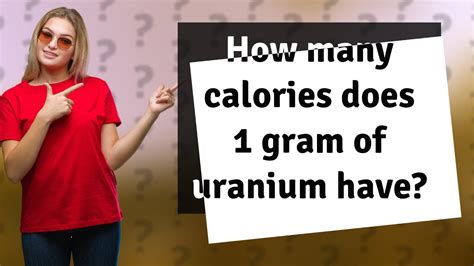How Many Calories In 1 G Of Uranium
Kalali
Mar 28, 2025 · 4 min read

Table of Contents
How Many Calories in 1 Gram of Uranium? Unpacking Nuclear Energy and Calories
The question, "How many calories are in 1 gram of uranium?" seems simple, but it delves into a complex interplay of physics, chemistry, and the very definition of "calorie." The answer isn't a straightforward number like you'd find on a food label. Understanding why requires exploring the nature of nuclear energy and its relationship to the chemical energy we measure in calories.
Understanding Calories: A Chemical Perspective
Before tackling uranium, let's clarify what a calorie means. A calorie (specifically, a kilocalorie, often written as Calorie) represents the amount of energy needed to raise the temperature of 1 kilogram of water by 1 degree Celsius. This is a measure of chemical energy, the energy stored in the bonds between atoms within a molecule. When we burn food, we're breaking these bonds, releasing that energy as heat.
Uranium: A Source of Nuclear Energy
Uranium, unlike food, doesn't contain energy in the form of chemical bonds that we can readily access and measure in calories. Instead, uranium's energy lies within its atomic nucleus. This is nuclear energy, a far more potent force than chemical energy. This energy is held together by the strong nuclear force, an incredibly powerful binding energy that holds protons and neutrons together in the nucleus.
Nuclear Fission: Unleashing the Power
The energy stored in uranium's nucleus is released through a process called nuclear fission. This involves splitting a uranium atom's nucleus into smaller nuclei. This splitting releases an enormous amount of energy compared to chemical reactions, because a small amount of mass is converted into energy, as described by Einstein's famous equation, E=mc².
Calculating Energy Released: E=mc²
Einstein's equation, E=mc², relates energy (E) to mass (m) and the speed of light (c). During nuclear fission, a tiny fraction of the uranium atom's mass is converted into a massive amount of energy. This is why nuclear reactions release so much more energy than chemical reactions. However, calculating the exact energy released in calories from 1 gram of uranium is not straightforward.
Challenges in Direct Calorie Calculation
We can't directly equate the energy released in nuclear fission to calories in the same way we do with food. The energy released in fission is typically measured in joules (J) or other energy units, not calories. To convert joules to calories, we use the conversion factor: 1 calorie = 4.184 joules.
The complication arises because the energy released from fission depends on several factors, including:
- Isotope: Uranium exists in several isotopes (atoms with the same number of protons but a different number of neutrons). Uranium-235 (²³⁵U) is the most commonly used in nuclear reactors due to its fissile nature, but its energy output per fission event differs slightly from other isotopes.
- Fission process: The exact products of fission are not always consistent. Different fission products will carry away varying amounts of energy as kinetic energy, radiation (gamma rays, beta particles, etc.), and heat.
- Efficiency of energy conversion: Not all the energy released in fission is converted into usable heat. Some energy is lost as radiation that escapes the reactor or as neutrinos, which interact weakly with matter.
- Reactor Design: The design of a nuclear reactor significantly influences the efficiency of energy extraction and conversion to heat.
Indirect Energy Estimates
Despite the difficulties, we can make an indirect estimate. The complete fission of 1 gram of ²³⁵U releases approximately 83.14 Terajoules (TJ) of energy. This is an enormous amount of energy! To put it in perspective, this is enough energy to power a typical household for many years.
Converting this to calories, we get:
83.14 TJ * (10¹² J/TJ) * (1 cal/4.184 J) ≈ 1.986 x 10¹⁶ calories
Important Considerations:
- This is a theoretical maximum. In reality, the energy actually harnessed from 1 gram of uranium in a nuclear reactor will be considerably less due to inefficiencies in the fission process and energy extraction.
- The Danger of Nuclear Energy: This immense energy release is what makes nuclear fission both a powerful energy source and a potential hazard. The uncontrolled release of this energy can have devastating consequences.
Conclusion: Beyond Simple Calories
While we can perform calculations to estimate the energy released from 1 gram of uranium in terms of calories, it's crucial to remember that this differs fundamentally from the caloric content of food. The energy in uranium is nuclear energy, an enormously powerful force governed by the laws of nuclear physics, not the chemical energy of molecular bonds. The "calories" in this context serve as a relative comparison to the energy we consume in food, but the underlying mechanisms and safety considerations are vastly different. Understanding these distinctions is essential for appreciating the power and potential dangers of nuclear energy.
Latest Posts
Latest Posts
-
What Tpye Of Reacgion Is Word Bank
Mar 31, 2025
-
80 Minutes Is How Many Hours
Mar 31, 2025
-
How Many Electrons Are In The Outer Shell Of Carbon
Mar 31, 2025
-
Cuanto Es 30 Grados Fahrenheit En Centigrados
Mar 31, 2025
-
2 And 5 8 As A Decimal
Mar 31, 2025
Related Post
Thank you for visiting our website which covers about How Many Calories In 1 G Of Uranium . We hope the information provided has been useful to you. Feel free to contact us if you have any questions or need further assistance. See you next time and don't miss to bookmark.
